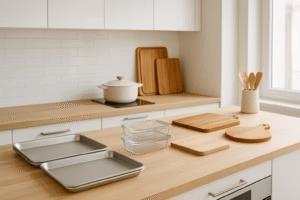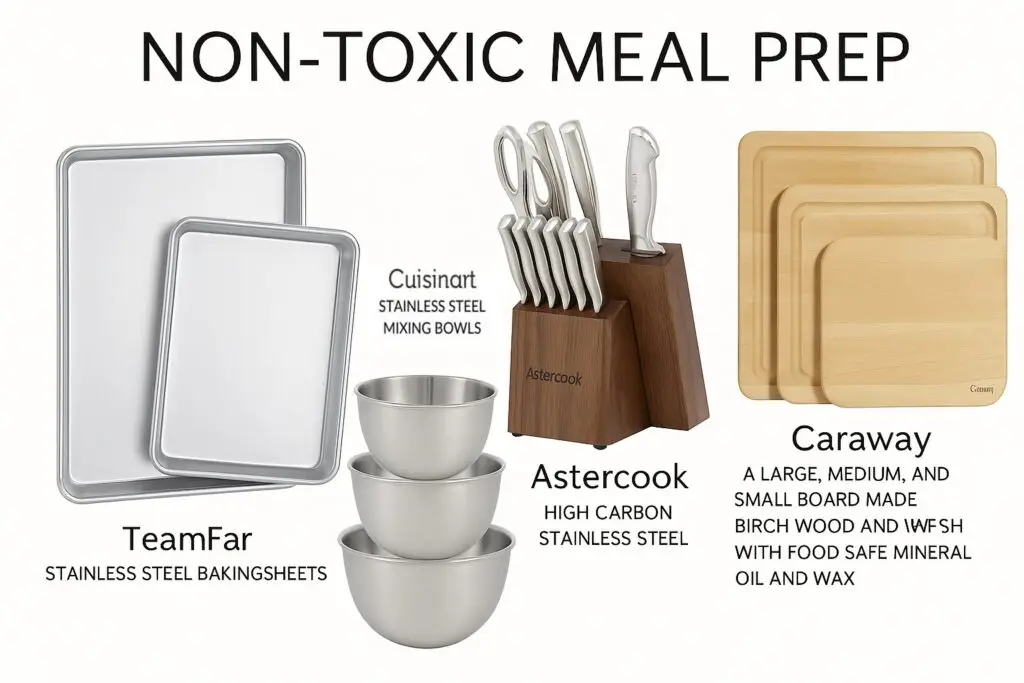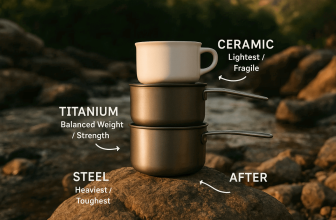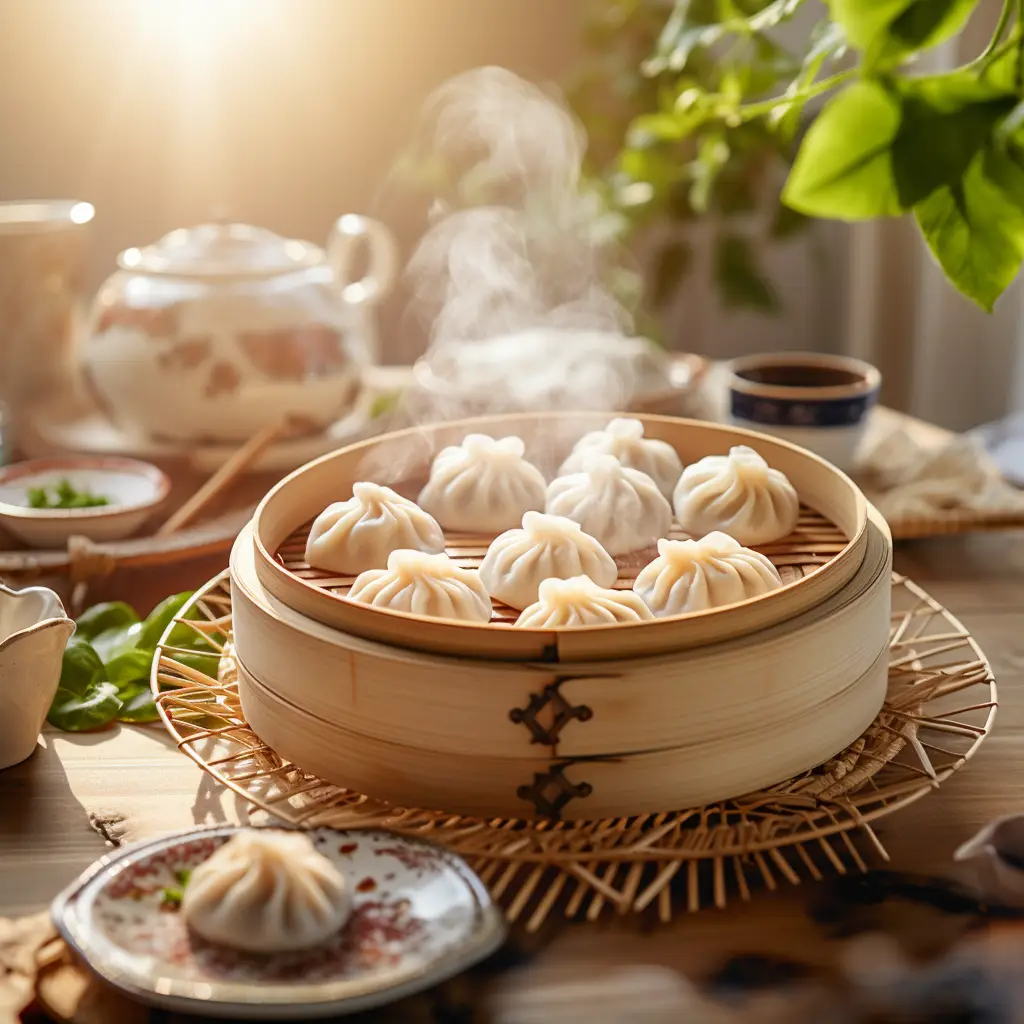How to Choose the Best Non-Toxic Kitchen Swaps Without Getting Overwhelmed
I’ll never forget the moment I realized just how many hidden chemicals were lurking in my kitchen. It started innocently enough—just me, late one night, reheating leftovers in a plastic container. I noticed the plastic had warped a bit in the microwave and thought, Hmm, that can’t be good. So I started digging. What I found shocked me: plastic containers leaching BPA, Teflon pans releasing toxic fumes, and even my colorful sponges shedding microplastics. That was the wake-up call I didn’t know I needed.
That night kicked off my journey into non-toxic kitchen swaps—and wow, it changed everything. I didn’t grow up thinking about toxins in cookware or food storage, but once I knew better, I couldn’t ignore it. I started replacing items little by little, from plastic mixing bowls to my old nonstick skillet. At first, it felt overwhelming. But as I made these swaps, something incredible happened: I felt calmer, more confident in my choices, and strangely proud of creating a non toxic kitchen I could trust. And yes, my food tasted better too (bonus!).
In this post, I’ll walk you through my personal experience and the simple non-toxic kitchen swaps that actually stuck. Whether you’re just starting out or ready for the next step in your low-tox lifestyle, I’ve got practical, science-backed tips that won’t stress your budget or your schedule. Because trust me, if I can do it—working full-time and juggling family life—you can too. Let’s get into it.
Why Go Non-Toxic in the Kitchen?
Our bodies build up the effects of things we do every day. Every chemical or heavy metal that comes into contact with cookware, containers, cleaning sprays, and other things drips a bit into it, like a bucket. That bucket can overflow into health problems over time. The Environmental Working Group (EWG) says that common kitchen chemicals like PFAS and BPA are linked to serious health problems. PFAS, which are “forever chemicals” used in nonstick coatings and food wrappers, can mess with hormones. BPA, which is found in many plastics and can linings, is a synthetic estrogen that can mess with our endocrine system. Research from the NIH also links PFAS exposure to a weakened immune system, thyroid problems, and even a higher risk of diabetes. In short, the things we do in the kitchen every day, often without realizing it, add up.
Cooking at home is supposed to be healthy, but it can become a recipe for hidden toxins if we’re not careful. For instance, heating a scratched Teflon pan releases polymer particles into the air. A Medical News Today review explains that high-heat cooking on PTFE (Teflon) creates toxic micro- and nanoplastics, which we can unknowingly inhale or ingest. I learned this firsthand: after swapping my old Teflon pan for a stainless steel skillet, not only did my veggies brown better, but I also realized I no longer got those weird headaches that used to flare up while cooking. It was my first demonstration that small substitutions may make a noticeable effect.
Even everyday things like our dish soap or dishwasher pods can have hidden dangers (many have synthetic fragrances or preservatives that can cause allergies). Kids are especially at risk. For instance, one woman I spoke with said that her toddler’s eczema got a lot better when the family stopped using plastic bottles and harsh chemical cleansers. That’s why scientists from the NIH and EWG say to be careful about what you use in the kitchen. Plastic containers and wrappers can leak PFAS and heavy metals into our food when they are cooked, according to EWG. All of this made me sure: my kitchen had to be part of the solution, not the problem.
It isn’t about perfection or fear. It’s about gradually tipping the odds in our favor. One modest switch at a time – like picking a glass storage jar over a plastic container – can lessen the total chemical load in our bodies. And when I observed even one minor effect, like fewer headaches or nicer skin, it kept me motivated. You will find the same motivation here, along with science-based reasons from the EWG, NIH, and other groups to help you make decisions.
The 5 Most Dangerous Things in a Kitchen

We all have those kitchen tools that we use every day, but some of them might be doing more harm than good. Here are five common “toxic” things and easy ways to get rid of them. Every swap not only lowers chemical exposure, but it also comes with extra benefits like durability or flexibility.
Non-stick pots and pans are made of ceramic or stainless steel.
PFAS, which is in the same family as Teflon, is used in almost all “non-stick” pans to keep food from sticking. Over time, tiny particles from the coating can flake into our meals, and heating them to high heat releases fumes. The alternative? A pan made of strong stainless steel or ceramic. No hazardous coatings mean you may safely sear, stir-fry, and even bake without worrying about PFAS. Stainless pans are extremely indestructible – no chipping – and properly transmit heat, so your food cooks better. For instance, TeamFar’s stainless steel baking sheets are “made of high quality pure stainless steel” with “no… toxic aluminum” and are rust-resistant. You’ll get better browning on roasted vegetables and a pan that lasts for decades.
Wraps and containers made of plastic → glass or silicone.
It’s easy to microwave leftovers in plastic or seal bowls with plastic wrap, but be careful: plastics often have BPA or phthalates in them, and even BPA-free plastics can leak other chemicals. According to EWG, putting food in plastic or heating it up can let PFAS and BPA get into your food. Change to glass or high-quality silicone containers to fix the problem. Glass jars and bowls don’t leech any chemicals, plus you can view your food at a glance. Silicone bags (like those reusable zipper bags) are lightweight, heat-resistant, and even keep things sealed. The best part? Glass and silicone endure almost forever and clean up in the dishwasher, saving time.
Plastic cutting boards → FSC-certified wood or bamboo.
Those well-worn plastic cutting boards can conceal more than knife scratches. Studies demonstrate that every slice might transport small shards of plastic into the air and onto your food. Microscopic pieces might not seem terrifying, but they’re effectively microplastics in your salad. Plus, major wounds on plastic boards might trap microorganisms. Wood and bamboo boards are inherently antibacterial and get sterilized by cutting (the wood fibers absorb germs and then naturally destroy it). Look for Forest Stewardship Council (FSC) certified wood boards – it signifies the wood is responsibly obtained. Caraway’s boards, for example, are “constructed entirely of FSC-certified birch wood” with “no plastics, no BPA”. These boards feel excellent, heal small knife-gouges over time, and you can even oil them once in a while for life.
Synthetic sponges → Natural fiber or biodegradable sponges.
That bright yellow sponge might clean dishes brilliantly, but it’s generally polyester or plastic foam behind the hood. Each time you scrub, small synthetic fibers shed into the water and down the drain. A New York Magazine piece adds that throwaway plastic sponges “can also shed microplastics, leaving the planet a bit more polluted with each use,” and experts advocate biodegradable choices. Swap in natural cellulose or coconut-fiber sponges and towels instead. They clean just as efficiently (some even have a rough side for scrubbing), but they’re manufactured from plant fibers that break down in compost. They’re generally marketed as multi-packs and last longer (less stench, too!). Plus, natural sponges don’t require harmful antibacterial agents.
Aluminum foil & bakeware ⇒ Uncoated stainless steel or glass bakeware.
Aluminum cookware and foil are widespread, but research urges caution. One research found that persons who used aluminum pots and pans every day had twice as much metal in their blood as people who didn’t use them. The group that was exposed to aluminum also had higher oxidative DNA damage. Aluminum may even seep out of foil into acidic meals. You may easily switch to using stainless steel or enameled cookware for baking and cooking. Stainless steel sheets and pans heat up effectively for baking (even better with a little oil for crispness) and don’t have any harmful coatings. Another safe alternative for the oven is glass bakeware, like Pyrex. If you switch out aluminum for stainless steel, you’ll be less exposed to metal. You might even find that stainless steel tools are your new favorite for even roasting and broiling.
Not only do these substitutions get rid of pollutants, but they also make cooking more fun. For example, it felt like I was cooking in a professional kitchen when I moved to a sturdy stainless steel mixing bowl set (no more plastic bowls flying about). And the glass containers I started using not only smell fresh, but I can also stack them in the dishwasher without worrying about them warping. When you make a cleaner adjustment, you’ll be amazed by the small victories and praises from your family.
Here are some strategies that have worked for me in the past:
Start with the most important things and work your way up. I started with my main frying pan, which I used every day. I sensed a difference right away when I changed one thing I used all the time. You may start by switching your water bottle to stainless steel or your storage containers from plastic to glass. Don’t try to accomplish everything at once; instead, work on one category at a time, such kitchenware, storage, or cleaning supplies.
Plan for quality
Non-toxic items are frequently of superior quality and cost more up front (unlike cheap Teflon pans). I needed to change the way I thought about these purchases and see them as long-term investments. For instance, the stainless steel pan I bought ten years ago is still running strong, whereas I used to have to buy fragile nonstick pans every few years. Many businesses stick by their stainless and cast iron goods, so look for those with a “lifetime warranty.” You could pay less over time since you won’t have to acquire plastic or coated things that wear out rapidly.
Make a list of things you want and wait for sales
I had a list on my phone of things I wanted, including a new baking sheet and a bamboo cutting board. Then I would wait for deals, like Christmas discounts or Amazon Prime Day, before I bought. This saved money and time running in stores. For example, I scored a Caraway cutting board set on cheap by waiting for a Christmas discount. Patience is your ally: signing up for a brand’s newsletter (they’ll typically offer a 10% off voucher) can make the move painless on your budget.
Replace one thing at a time
Instead of buying a full “clean kitchen kit” at once, go item by item. I initially switched from my previous detergent, which was full of scents, to a pleasant, plant-based soap. Then, next month, I switched my Tupperware. This helped us stay to our plan and kept me sane.
Choose multi-taskers
Some safe options can accomplish more than one thing. A glass mixing bowl, for example, may also hold leftovers. Linen bowl covers are a lovely way to cover bowls on your counter instead of plastic wrap that you throw away after one usage. It’s worth the money and saves space when one thing can do more than one thing.
I understand that it might feel slow to make adjustments at first. I was apprehensive that switching from a plastic spatula to a wooden one wouldn’t make a difference, but now I can’t image using the old plastic ones (and they would certainly melt if I tried!). Remember, it’s not about being flawless right away. Stainless steel doesn’t wear out quickly, and glass containers won’t leak chemicals, so every little thing you do adds up over time. And you’ll be proud every time you open your refillable soap bottle or use a new wooden spoon instead of a disposable one.
My Favorite Non-Toxic Kitchen Must-Haves
I’ve used a lot of things on this trip. Here are a handful that I really liked and that I have used in my (admittedly busy) kitchen. I go back to each one over and over, not just for safety but also because they are useful:
TeamFar Stainless Steel Baking Sheets
These pans are rock-solid. The product information says that they are “made of high quality pure stainless steel” with no “toxic aluminum” and that they won’t rust. That means they heat evenly and are easy to clean with one swipe (the mirror finish keeps food from sticking). I use them every week to roast vegetables and bake pastries. It’s also safe to put in the dishwasher, which saves time.
KitchenAid Stainless Steel Mixing Bowls
These heavy-duty bowls come in three sizes and are great for any kitchen. I like that they have strong bases (they don’t wobble when I whisk) and built-in handles and pouring spouts, but they don’t use any plastic. Because they are made of stainless steel, they don’t react with anything (so tomato sauce won’t taste weird) and are almost impossible to break. A buddy of mine borrowed them and never gave them back, so I got another set on cheap right away. These bowls are a must-have if you ever mix up a lot of something.
Astercook Knife Set
Sharp knives make cooking safer and more pleasant. My Astercook knife set has blades made of high-carbon stainless steel that are covered in a ceramic coating that keeps them from rusting. (Ceramic coatings can be safer than chemically-coated blades.) They keep remarkably sharp, making it easy to chop herbs or cut up vegetables. There is a nice bamboo block with the package to keep them in. I recognized how much easier it was to chop onions with this set the first time I used it. I had been using dull blades all those years! Each knife also comes with a little plastic shield that keeps them in great shape and makes them easy to go camping or on a trip.
Cutting Board Set from Caraway
These seemed like a waste of money, but they were worth it. Caraway says the set is constructed of “FSC-certified birch wood” and contains “no plastics, no BPA.” The surfaces are very smooth, and they came in three sizes: one for vegetables, one for bread, and one for cheese. They are also reversible and thin enough to stand up when you store them. I started using the biggest one every day. It’s lighter than my previous plastic board and looks better on the counter. Over time, little knife marks will organically patina it. These boards won’t warp and won’t have any microplastics from knife cuts if you take care of them by oiling them every now and then.

All of these must-haves are “clean” by design and useful. They’ve held up under a lot of stress (believe me, I really do push them to the max, like when I have a full oven and a blender running on high). And they fit well in with a hectic existence. These are great tools, so my cooking flow didn’t alter. The only difference is that I feel good about using them.
A Reader’s Journey from Toxic to Trusted: Making the Kitchen Safer
I couldn’t figure out why my daughter’s eczema got worse last spring. She had blotches on her cheeks for months, and nothing seemed to help. One night, after a really hard day, I was surfing through Instagram when I saw a post about toxins in the kitchen. I believed there could be a link.
I never thought of myself as very “green” before, but as a mom, I was scared about putting her health at jeopardy. So I started to search. I learned that toxins from plastics and nonstick cookware may get into our meals. The next day, I looked through my cabinets. I noticed at least six warped plastic Tupperware lids in the dishwasher, a warped old nonstick skillet, and a bottle of bleach-based cleanser beneath the sink. It was too much.
I made the choice to go one step at a time. To start, I got rid of our plastic snack bags and containers and replaced them with glass jars and silicone bags. I could tell right away that our food didn’t smell like plastic anymore. After that, I replaced the Teflon pan with a cast-iron skillet that had been seasoned with avocado oil. I also stopped using the chemical spray cleaner and instead used vinegar and Castile soap. Her skin was much smoother and not as scratchy after a few weeks. It could have been a coincidence, or it could have been the little things, but I stopped worrying about what we ate and how we cooked.
The kitchen changed over time. The old cleaner’s strong, bad smell was gone, and I actually liked the smell of vinegar now. Instead of mismatched plastic, our pantry shelves were full of neat rows of glass and ceramic. Everyone in the family was getting excited about these trades. My husband switched from using a plastic jug to a stainless steel French press to make coffee. He did this because he knew I had worked hard and wanted to help. And our daughter, who is almost eczema-free, jumps around with a big smile on her face. I told her one day, “You have a superpower: you make our kitchen clean and safe just by eating our dinner.” She laughed and said, “Mama’s cooking magic.”
I say this because you can change the way your family cooks, too. We all have a story, and this is ours.
Conclusion and Next Steps
Changing your kitchen to one that isn’t toxic isn’t about being scared; it’s about taking charge of your health and space, one swap at a time. Every time you exchange a plastic container for a glass one or a chemical cleaner for a natural one, you are reducing the amount of toxins in your body. These swaps are important because they keep you and your family safe from chemicals that aren’t needed, such heavy metals and endocrine disruptors, every day.
In summary, you’ve learned that small changes, like switching out one thing or habit, can make a big difference. Begin with the things you use the most that are the worst. You can see that I felt better and my kid’s skin cleaned up after I made one big adjustment (goodbye, Teflon pan!). You can do the same thing.
What you should do next:
Choose One Swap: This week, buy one non-toxic item (such a stainless steel mixing bowl or a bamboo board) and cease using an old harmful one. For instance, get rid of that one plastic food container you always use and replace it with a silicone or glass one that you can use again. This kind of little choice can help you build positive habits.
Join the Community: You’re not alone on this journey. Join our newsletter and online community to swap stories and tips with other health-conscious cooks. We share seasonal recipe swaps (using safe cookware, of course) and exclusive discounts on trusted non-toxic products.
This isn’t an agreement where you have to do everything. With each choice you make, you are giving yourself more power. One of my millennial friends said, “Every non-toxic dish I make feels like a vote for my health.” You are making progress toward a better kitchen and a healthier you, whether you alter one item today or five things by next month.
So what are you waiting for? Pick that product you’ve been eyeing and make the trade. Your future self – and maybe even your child’s skin – will thank you. Together, let’s develop kitchens we can trust.








